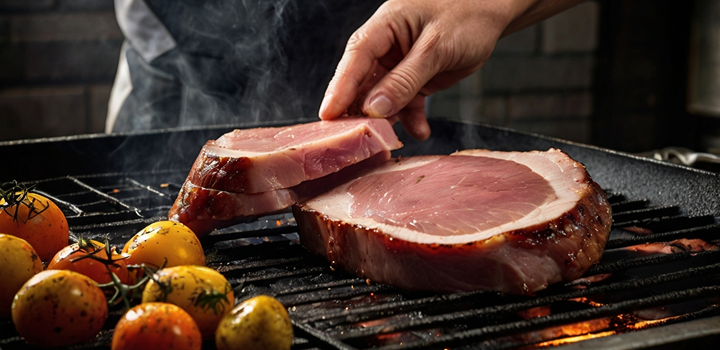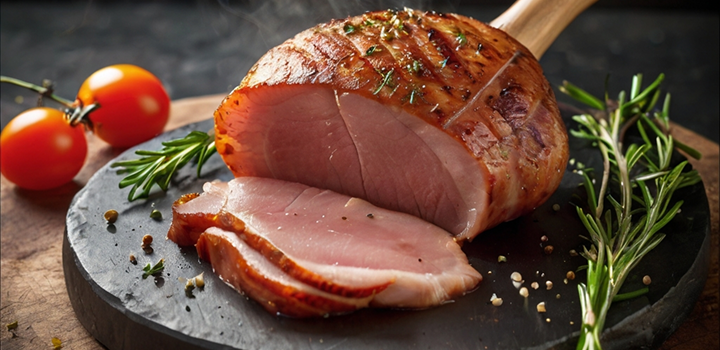Ham Steaks Done Right
Ham Steaks Done Right: A Simple Guide for Cooking Perfectly Every Time

Arianne Nemna
When you’re staring down a busy weeknight but still want something hearty, satisfying, and just the right amount of nostalgic, ham steak delivers. It cooks quickly, needs little prep, and fills the kitchen with the kind of savory aroma that feels like home. I’ve made ham steak every which way over the years, and whether you pan-fry it for crispy edges or glaze it until it’s sticky-sweet, it’s a dependable cut that never disappoints. In this guide, I’ll walk you through exactly how to select, cook, and enhance ham steaks so you can turn this humble cut into a standout meal—no culinary degree required.
Ham Steaks
What Is a Ham Steak?

A ham steak is a thick, cross-sectional slice from a whole cured ham, typically about half an inch to one inch thick. It carries all the deep, savory flavor of a traditional ham roast but in a form that’s faster and easier to cook. Ham steaks are often sold individually, making them ideal for weeknight meals or when you don’t need a whole ham. Their versatility makes them useful in both quick breakfasts and hearty dinners. Most ham steaks are pre-cooked, meaning they’re fully cured or smoked and only need reheating. However, some can be sold raw and require thorough cooking before serving.
Types of Ham Steaks: Bone-In vs. Boneless
The choice between bone-in and boneless ham steak comes down to flavor and convenience. Bone-in varieties tend to have more pronounced, deeper flavor due to the marrow and connective tissue near the bone, which release richness during cooking. These cuts are great for grilling or baking where the bone adds structure and taste. Boneless ham steaks, on the other hand, are easier to slice and serve, especially in recipes that call for diced or chopped ham. They cook more evenly and are ideal when preparing the ham in a skillet or as part of a dish where texture uniformity matters.
Selecting and Preparing Ham Steaks
Choosing the Right Ham Steak

When picking a ham steak, there are a few things to keep in mind that can affect the cooking process and final flavor. Look for even thickness throughout the slice to promote consistent cooking. Color matters too—rich pink or rose tones indicate freshness and proper curing, while dull or greyish ham may signal poor storage. Pay attention to the cut’s moisture level in the packaging; a lot of liquid might mean the meat will steam rather than brown when cooked. It’s also helpful to check whether sugar, honey, or other flavorings have been added, as this can influence how the meat behaves under heat and whether it’s suitable for savory vs. sweet applications.
Pre-Cooked vs. Uncooked Ham Steaks
Most ham steaks you’ll find in grocery stores are pre-cooked, sometimes labeled as “fully cooked” or “ready to eat.” These only need gentle reheating to restore their tenderness and flavor, which makes them ideal for fast meals. Uncooked ham steaks, though less common, need to be cooked to a safe internal temperature of 145°F (63°C) to be safe for consumption. If you’re unsure whether your ham is raw or pre-cooked, read the label closely. Knowing this affects everything from cooking time to seasoning—pre-cooked steaks already have salt, so they don’t need much more.
Cooking Methods for Ham Steaks
Pan-Frying for Quick Meals

Pan-frying is my go-to method when I want ham steaks on the table fast. I use a heavy-bottomed skillet—cast iron is perfect—and heat it over medium. If the ham steak is pre-cooked, I aim for 3 to 4 minutes per side to get a golden brown crust. I don’t add much oil; ham releases fat as it cooks, and too much added fat will make it greasy. The key here is timing. Pre-cooked steaks should only be heated until warmed through to avoid drying out, while uncooked steaks need a bit longer. I always check that raw steaks reach 145°F internally, using a meat thermometer for accuracy.
Baking for Even Cooking

When I have more time, baking offers a hands-off way to ensure even heat distribution. I preheat the oven to 350°F (175°C) and place the ham steak in a shallow baking dish with a splash of broth, juice, or even water to maintain moisture. Covering with foil helps prevent the surface from drying out during the bake. A pre-cooked steak takes about 20 minutes, while raw may need closer to 30, depending on thickness. I like to add a glaze during the last 10 minutes to form a flavorful coating.
Grilling for a Smoky Flavor
Grilling brings out the natural saltiness of the ham and infuses it with smoky depth. I set up a medium heat zone and oil the grates lightly to prevent sticking. For a half-inch thick steak, 4 minutes per side is enough. I avoid high flames—ham is already cured and can burn quickly. I sometimes brush a glaze on during the final minute on each side to caramelize it without risking scorching. It’s especially effective with bone-in cuts, which hold their shape better on the grill.
Broiling for a Caramelized Finish
Broiling is a high-heat method I reserve for when I want the glaze to really shine. I place the ham steak on a broiler pan and position it about 5 inches from the broiler element. Pre-cooked steaks need only 2 to 3 minutes per side; raw versions should be cooked on a lower oven rack first, then finished under the broiler to brown. Glazes like brown sugar or honey work beautifully here, creating a sticky crust that enhances each bite. Just keep an eye on it—sugar burns fast.
Glazing and Flavor Enhancements
Classic Brown Sugar and Mustard Glaze

This glaze is a staple for a reason. The sweetness of brown sugar balances the saltiness of the ham, while mustard brings a sharp kick. I usually mix ¼ cup brown sugar with a tablespoon of Dijon or yellow mustard and a teaspoon of vinegar or water to thin it out. I warm it slightly before brushing it over the ham steak in the last few minutes of cooking—pan, oven, or broiler. It forms a glossy, savory-sweet coating that clings to the meat.
Pineapple and Honey Glaze
For a tropical profile, I mix pineapple juice with honey and a hint of ginger. About ½ cup juice to 2 tablespoons of honey works well. I reduce the mixture on the stovetop until slightly thickened, then brush it over the ham steak as it finishes cooking. This glaze pairs especially well with grilled or broiled ham, where the sugars can caramelize properly. The acid from the pineapple also tenderizes the surface just enough to enhance texture without breaking it down too much.
15+ Frequently Asked Questions
How do I know if my ham steak is pre-cooked?
Check the label. If it says “fully cooked,” “ready to eat,” or “smoked,” it’s pre-cooked. If it says “fresh” or gives instructions for internal temperature, it’s likely raw.
Can I eat ham steak cold?
Yes, if it’s fully cooked. You can slice it thin and use it in sandwiches, wraps, or breakfast dishes without additional cooking.
What internal temperature should uncooked ham steak reach?
145°F (63°C), followed by a 3-minute rest. Use a meat thermometer to be safe.
Do I need to glaze ham steak?
No, but glazing enhances both flavor and appearance. It’s especially useful for broiled, baked, or grilled versions.
Can I cook ham steak straight from frozen?
It’s best to thaw it in the fridge first. Cooking from frozen may lead to uneven results, especially with raw steaks.
What side dishes pair well with ham steak?
Mashed potatoes, sautéed greens, mac and cheese, or roasted vegetables are all great choices depending on the cooking method used.
Can I use ham steak in soups or casseroles?
Absolutely. Just dice it and add it near the end of cooking so it doesn’t dry out.
How long does cooked ham steak last in the fridge?
3 to 5 days if stored properly in an airtight container.
Can I freeze ham steak?
Yes, both raw and cooked. Wrap tightly in foil or plastic, then place in a freezer-safe bag. Use within 2 months for best quality.
Why is my ham steak tough?
It was likely overcooked or cooked at too high a temperature. Stick to medium heat and don’t exceed cooking times for pre-cooked cuts.
Should I salt ham steak before cooking?
No. Most ham steaks are already salted or cured. Adding salt can make them too salty.
Can I make a gravy from ham steak drippings?
Yes. Use the pan juices and thicken them with cornstarch or flour slurry. Add herbs, mustard, or stock to boost flavor.
What’s the best way to reheat ham steak?
Use a skillet on low heat or wrap in foil and warm in a 300°F oven. Avoid microwaving, which can toughen the texture.
Is ham steak the same as pork steak?
No. Ham is from the hind leg and usually cured or smoked. Pork steak comes from the shoulder and is typically raw.
Can I make ham steak in a slow cooker?
Yes, but it’s usually unnecessary. Ham steak cooks quickly with other methods. If using a slow cooker, keep the time under 2 hours on low to prevent overcooking.







